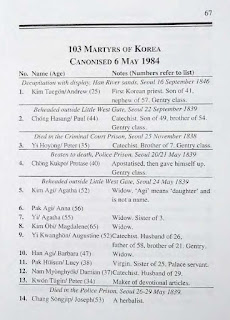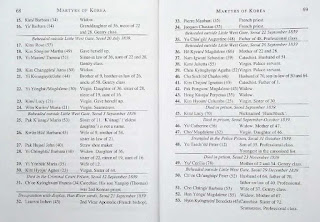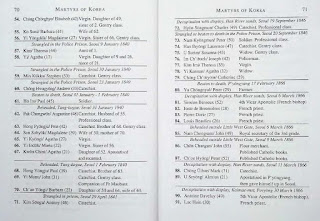Martyrs of Korea
Father Richard Rutt
Catholic Truth SocietyISBN 9781860821516
CTS Booklet B668

I stumbled across this volume while doing research for a review of a different book from the Catholic Truth Society. I had read many books in the CTS 20th Century Martyrs Series, I discovered in the back of one a book I had not heard of and it led me to this volume and several others that are currently out of print, they are:
Martyrs of Korea
The Martyrs of Uganda
Martyrs of Nagasaki
Martyrs of Vietnam:
Saints Andrew DungLac, Jean Theophane Venard and Their Companions
And a few more titles in the 20th Century series. To date this is the only one I have been able to track down and it was well worth the effort and so worth the read. Over the last several years I have read over 250 books and booklets from the Catholic Truth Society, there are many great series and many wonderful authors. Some of the books are not easy reads, and I include this one in that list, reading about Martyrs of the 20th Century, from England, Ireland and Wales, and now the Orient are not always easy to read. But they are important reads, and these are stories we should know. But of all the books I have read about Martyrs this one is by far the hardest. The means of torture and execution used are not for the feint of heart.
The description of this volume is:
“The Church in Korea began in the late 18th century, and is to date the only local Church to have been founded entirely by lay people. Yet within a century this fledgling Church could count as many as 10,000 heroic witnesses to the faith among its number. The martyrs of Korea suffered the most painful torture and death courageously. In the words of Augustine Yu, who was himself martyred together with his wife, and son and brother and who was typical in his faith and bravery in the face of death: “Once having known God, I cannot possibly betray him.””
This volume was published in 2002, some 18 years after Saint John Paul II canonized 103 Martyrs of Korea on May 6th of 1984.
The chapters in the volume are:
Land of Morning Calm
A Chinese culture
Confucianism
Buddhists and shamans
Science and democracy
A Church Founded without missionaries
The First Martyrs
A woman in charge
Arrest and torture
Execution
1801, The Year of the White Cock
Thirty-five years waiting for a priest
French missionaries
A pastoral bishop
1839, The Year of the Yellow Pig
Three men and four women. 24 May 1839
One man and four women, 20 July 1839
The maker of straw shoes
Father of a priest
The good shepherd gives up his life for the sheep
Strong Women
Three male martyrs and three more women
Boy martyr
Paul’s mother
Winter martyrs
Strangulations
Five men and five women
Rebellion and poor harvests
Saint Andrew Kim
Eight friends
A twenty-year lull
1866, The Year of the Red Horse
8,000 Martyrs
Princess Mary
The martyrs’ heritage
Flowering of the Church in Korea
Korean Martyrs inscribed in the list of saints
103 Martyrs of Korea Canonized 6 May 1984.
I highlighted many passages while reading this volume, some of them are:
“Like China and Japan, Korea was a closed land, allowing neither foreigner in nor its own people out.”
“As for Christianity. well-read men had sometimes heard of it. Since the Churches of the Reformation had not yet begun missions in East Asia, for Koreans ‘Christian' meant 'Catholic'. They knew there were some Christians in China: but Christianity had been virtually extinguished in Japan, and was kept out of Korea because of respect for Confucius.”
“One of these young intellectuals was 30-year-old Yi Pyok. He was intrigued by what he read in books from China that were circulating among his friends. He discovered that the God of the Christians loved all men equally. This very reasonable doctrine might lead to changes in social justice. Perhaps he overestimated the stress placed on this point by the Catholic Church of that period, but it led him to further study of the Christian religion, and in 1777 he gathered a few friends of his own age for group study.”
“To become a Christian was dangerous.”
“Even though more Korean women than men have been canonised, the canonisation of Columba Kang would bring more attention to the powerful role of women in the story of Korea's martyrs. In periods of persecution women are always vital to the strength of the Church: they train their sons and daughters to be ready for martyrdom. Columba did more. She was for seven crucial years the chief organiser of the Church.”
“During the decapitation of St John Pak the executioner actually withdrew after striking a few blows in order to whet his blade. Then he returned and finished severing the head.”
“Three hundred Christians were executed that year in an outburst of violence that has gone down in history as the ‘Persecution of the White Cock Year', because the Koreans numbered their years according to the twelve Chinese 'zodiacal' animals. Although there had been martyrdoms nearly every year since 1791, there was no policy of seeking out Christians until the Year of the White Cock. 1801, when a change of policy followed the accession to the throne in 1800 of a ten-year-old boy.”
“Pressure on Christians increased during spring and summer 1839, the Year of the Yellow Pig. A stern new decree against Christianity was published in April. We have records of some 140 martyrs during the whole year, in Seoul and several southern provincial cities, but this can be only part of the whole story.”
“Dispossessed Christians were taking refuge in the further parts of the country. Already some of them were becoming potters, because makers of earthenware traditionally travelled from place to place in search of suitable clay, setting up earth kilns in waste places and moving on when they had exhausted local clay deposits. Itinerant porters were to remain a feature of the Korean Catholic Church for two hundred years.”
“St Andrew is the best-loved of the Korean martyrs. Not only was he the first Korean priest, only 25 years old and not yet a year in the priesthood, he was an impressive and loveable young man. Bishop Ferreol said he loved him like a son. His judges acknowledged his fine character, and pitied him for the hard life that had been his lot. It is right that his name should stand at the head of the canonised.”
“These names from the 1860s are woefully unrepresentative. The choice of those canonized in 198-1- depended on the collection of evidence of the standard required for the canonical process. Not only are there no women among them, though large numbers of housewives and mothers were killed, but these saints of the Year of the Red Horse form only a tiny selection from what arc thought to be have been about 8,000 martyrs who died between 1866 and 1886. Few Churches can muster such a roll.”
“Persecution continued for several years. Families that suffered in 180 I and 1839 continued to suffer until the early 1870s. Among them were a son, grandson and two great grandsons of Peter Yi who took Chinese books to the Hermitage group in l 775 - four generations of martyrs in one family. Long af1er persecutions ceased. priests continued to live and work in secret. Only in 1886, when the first Franco-Korean treaty was signed, did the law relax.”
“In the days or the martyrs there were no separate Korean words for 'Catholicism· and 'Christianity'. The Chinese name for Christianity, devised by the great Mateo Ricci in the 16th century, served for both. It meant, literally, 'the God Doctrine’.”
“Thus Korean Protestants came 10 think of the Catholic martyrs as having died for a different religion. Some wise Protestant missionaries, however, expressed great reverence for the martyrs, and today Korean Christians all increasingly see themselves as their heirs. In the 1960s the Catholic Church in Korea agreed to use the word for God preferred by Protestants.”
“In 1984 Pope John Paul II visited Kore::t to celebrate the second centenary of the baptism of Peter Yi in Beijing and the birth of the Korean Church. On 6 May at the Han River sands where St Laurent Imbert. St Andrew Kim and many others bad suffered and died, he canonised 103 martyrs: 3 French bishops, 7 French priests, 46 Korean men and 47 Korean women. It was the first canonisation ever performed outside Rome.”
The back of the book has the list of the 103 with notes. I hope those few passages will inspire you to track down this volume. Or maybe one of the others named at the beginning of the review. It might not be an easy read and at times very unpleasant, but as stated it is an important read.
This is another excellent volume from the Catholic Truth Society. I highly recommend it.
For other books in the CTS 20th Century Martyrs Series click here, and here for all the Biographies from the CTS.
Books in the 20th Century Martyrs Series:
Sophie Scholl and the White Rose: Resistance to the Nazis - Helena Scott and Ethel Tolansky
Johann Gruber & Jacques Bunel Victims of the Nazis - Helena Scott and Ethel Tolansky
Maximilian Kolbe, F. Jagerstatter, K. Leisner, R. Mayer: Victims of the Nazis - Franz Jagerstatter
Edith Stein, Marcel Callo, Titus Brandsma: Victims of the Nazis – Matthew Monk
Saint Maria Goretti: Teenage Martyr for Chastity - Glynn MacNiven-Johnston
The Atlas Martyrs – Jean Olwen Maynard
Books in the 20th Century Martyrs Series:
Sophie Scholl and the White Rose: Resistance to the Nazis - Helena Scott and Ethel Tolansky
Johann Gruber & Jacques Bunel Victims of the Nazis - Helena Scott and Ethel Tolansky
Maximilian Kolbe, F. Jagerstatter, K. Leisner, R. Mayer: Victims of the Nazis - Franz Jagerstatter
Edith Stein, Marcel Callo, Titus Brandsma: Victims of the Nazis – Matthew Monk
Saint Maria Goretti: Teenage Martyr for Chastity - Glynn MacNiven-Johnston
The Atlas Martyrs – Jean Olwen Maynard
Jerzy Popieluszko Victim of Communism - Grazyna Sikorski
Isidore Bankanja - Jean Maynard
Gianna Molla - Jean Olwen Maynard
Isidore Bankanja - Jean Maynard
Gianna Molla - Jean Olwen Maynard















No comments:
Post a Comment